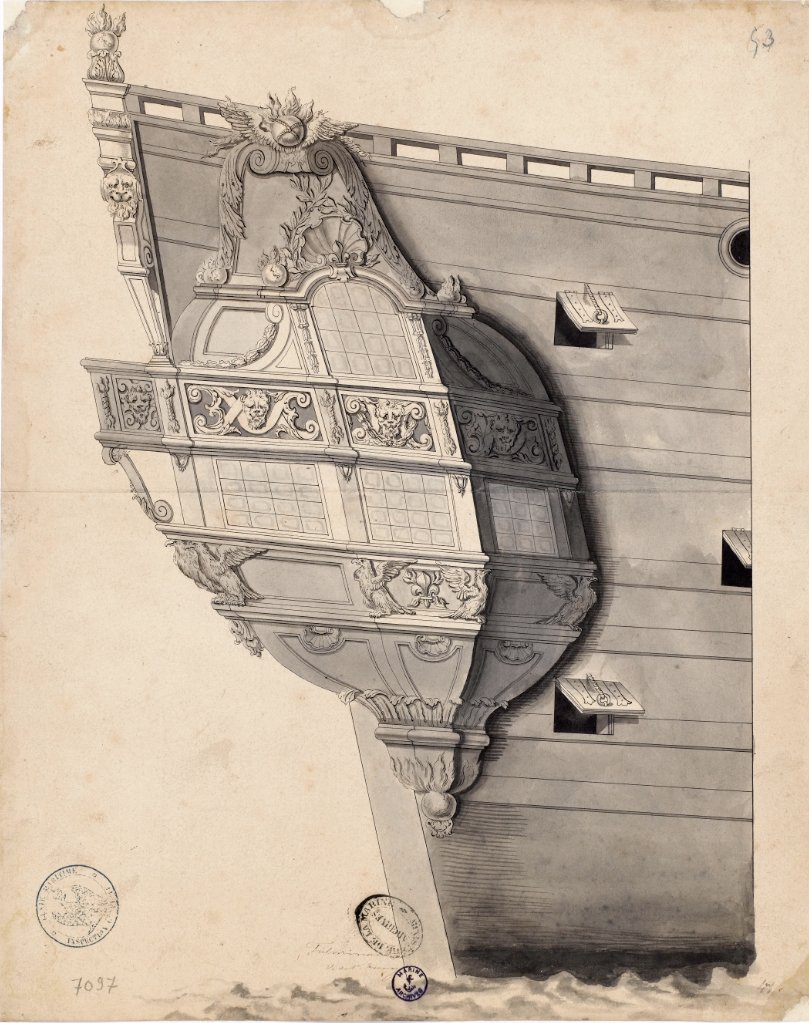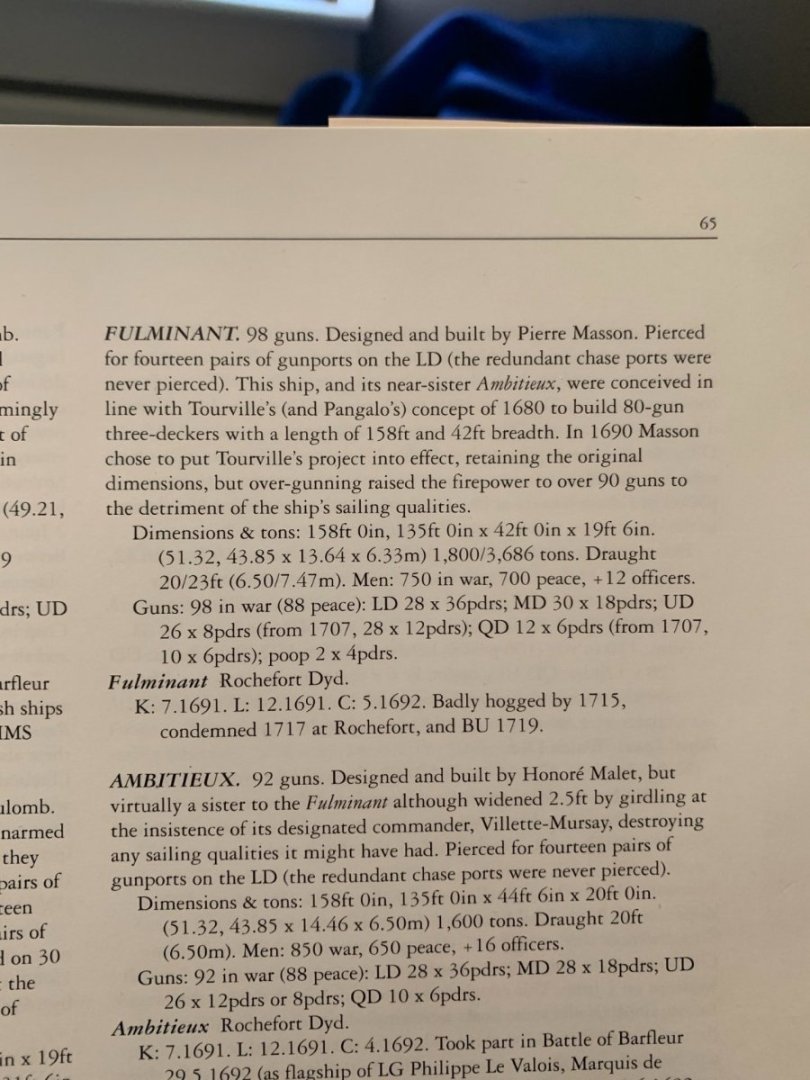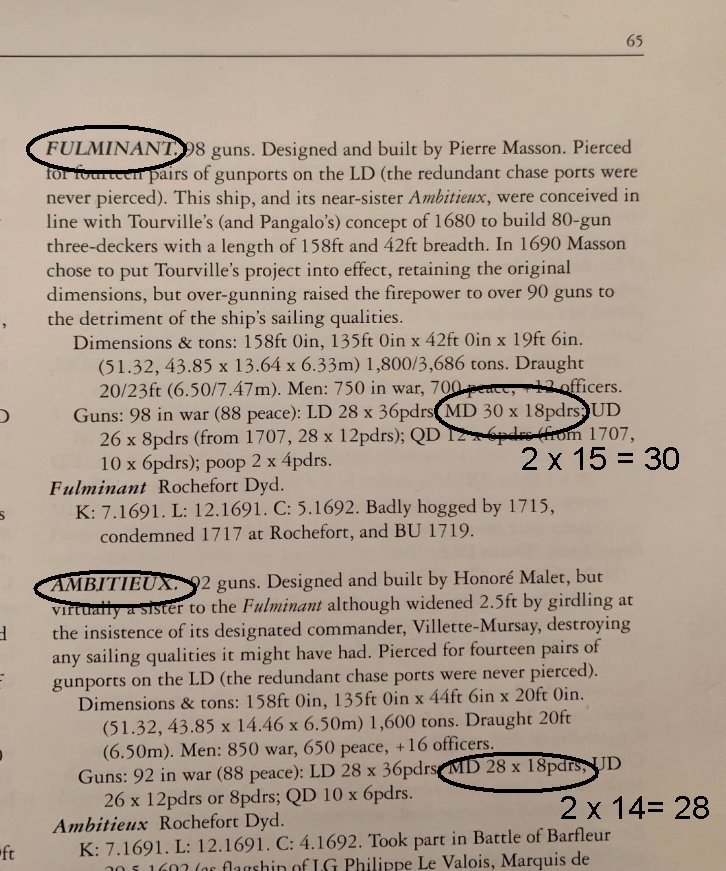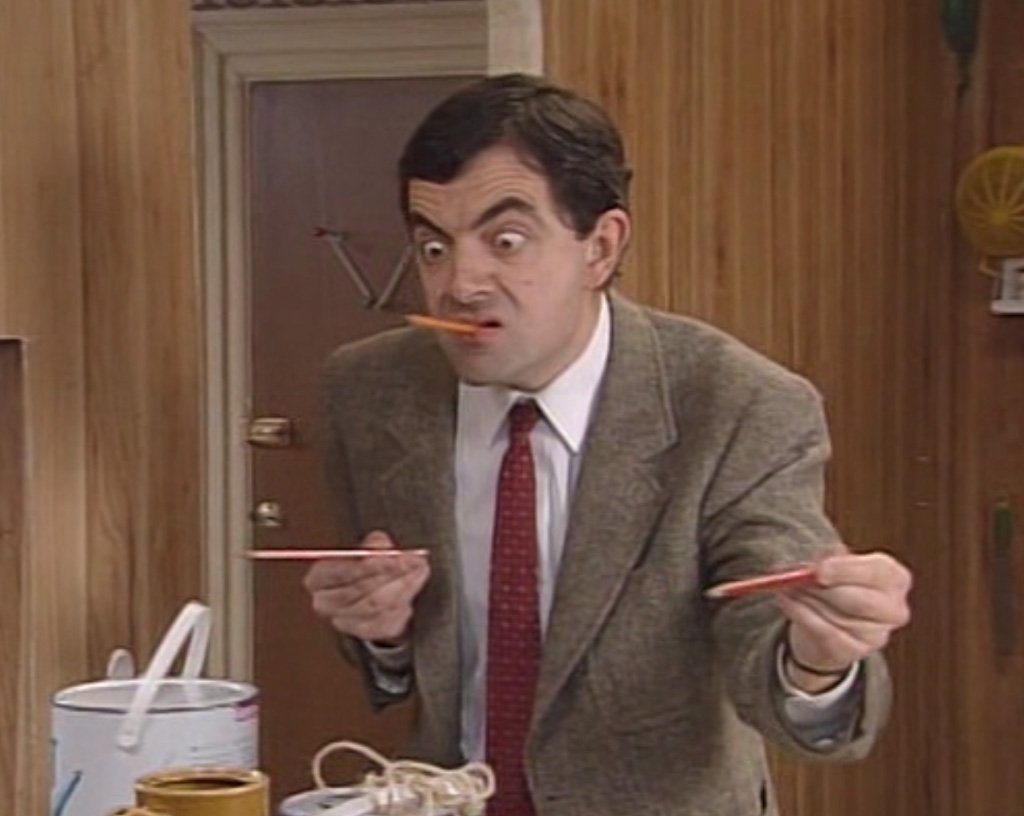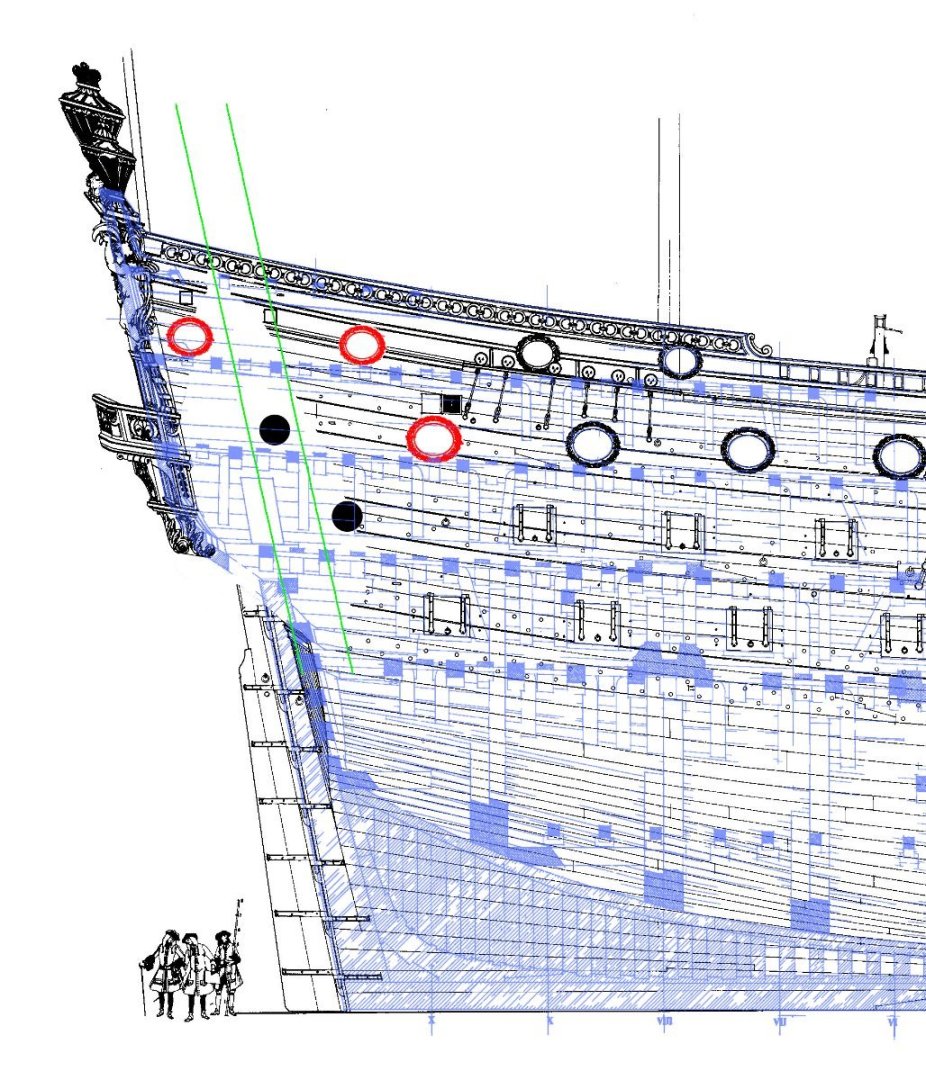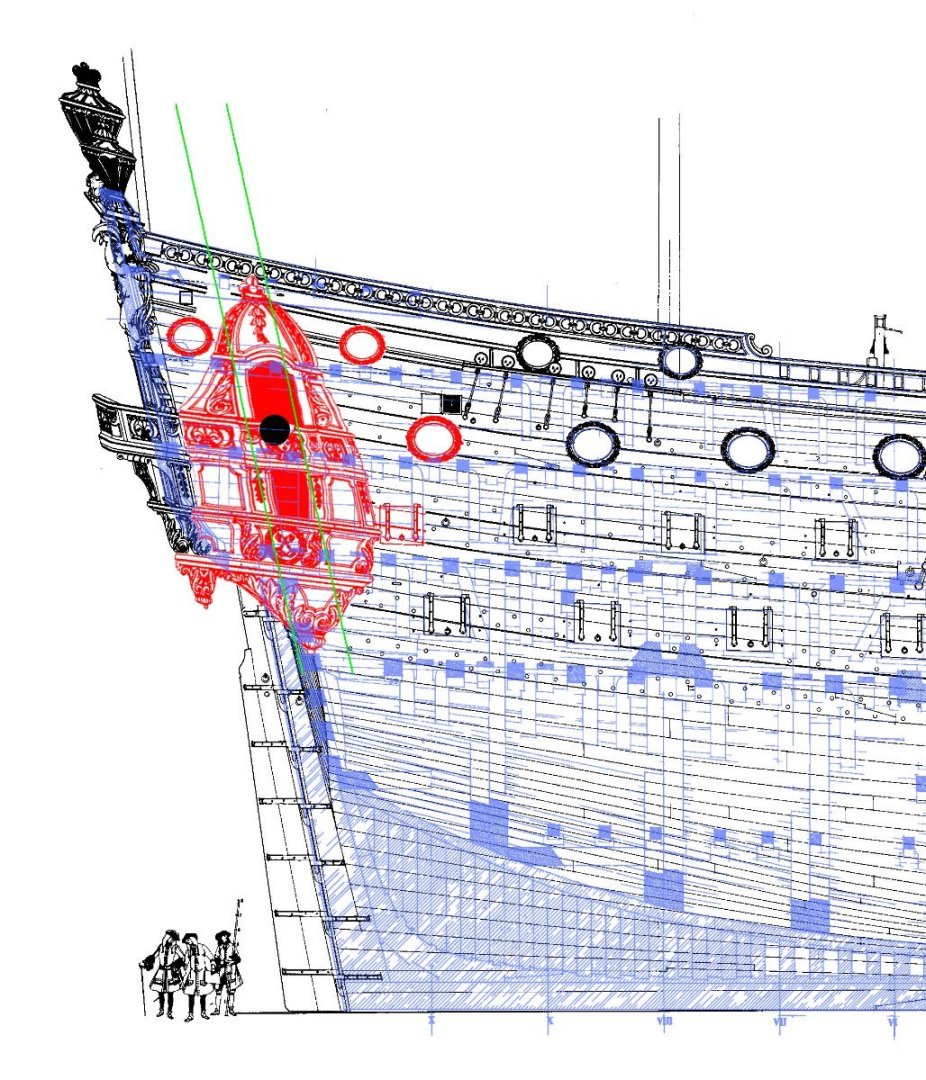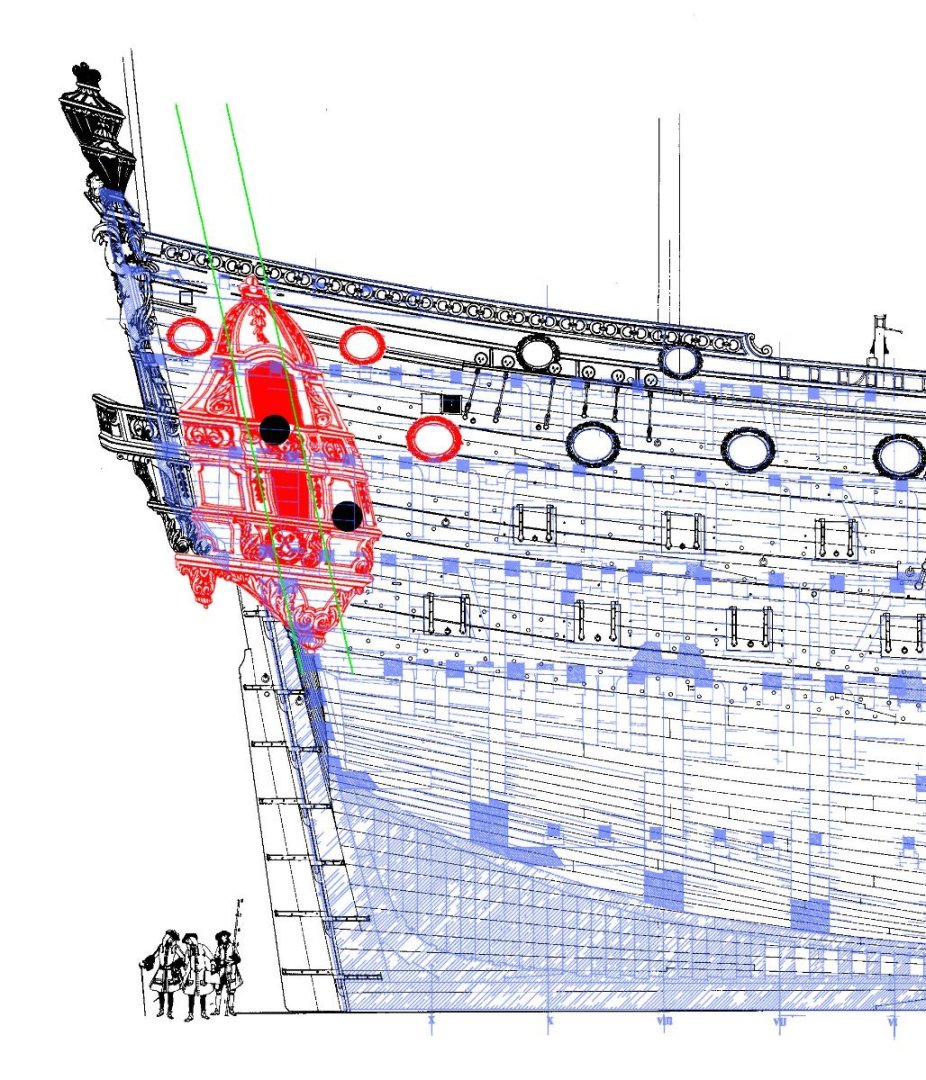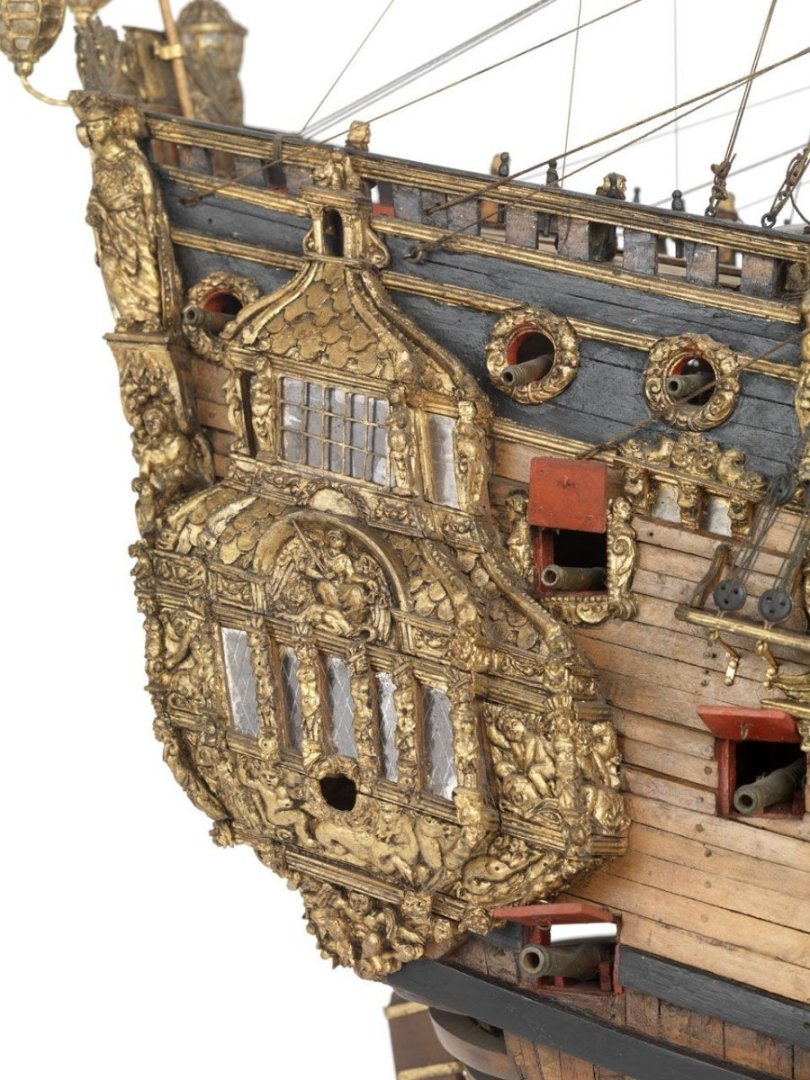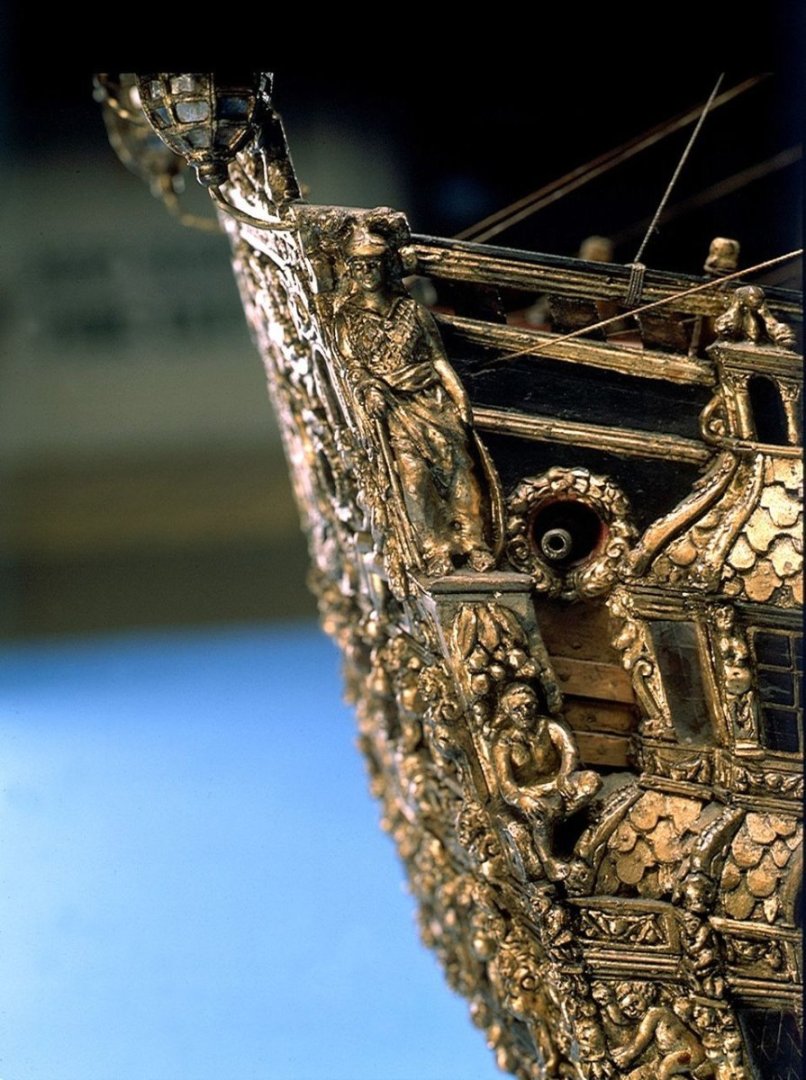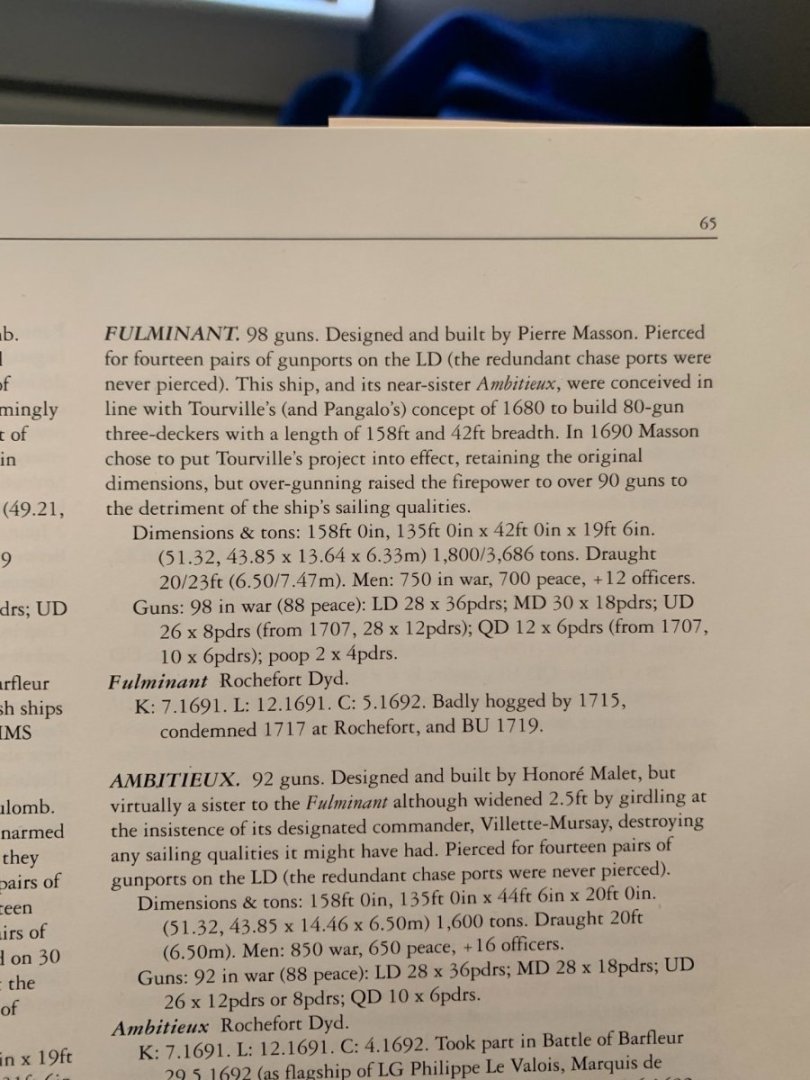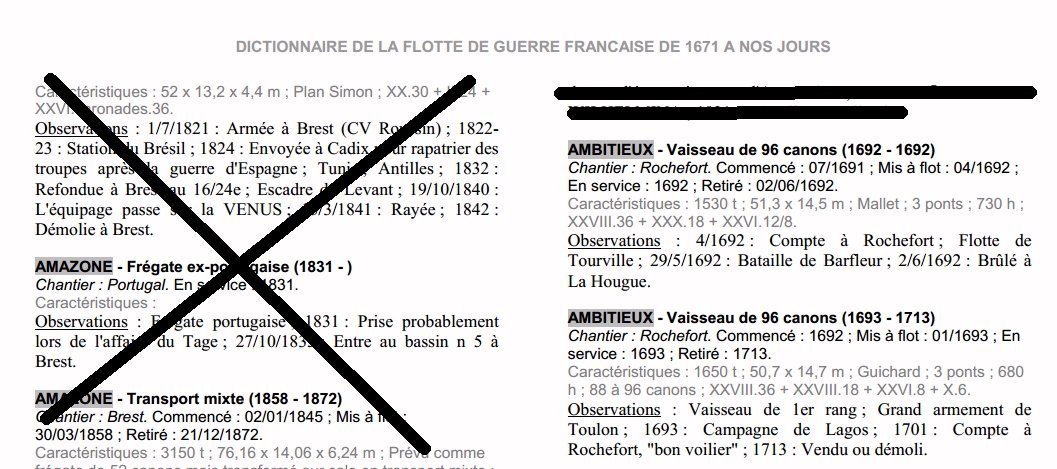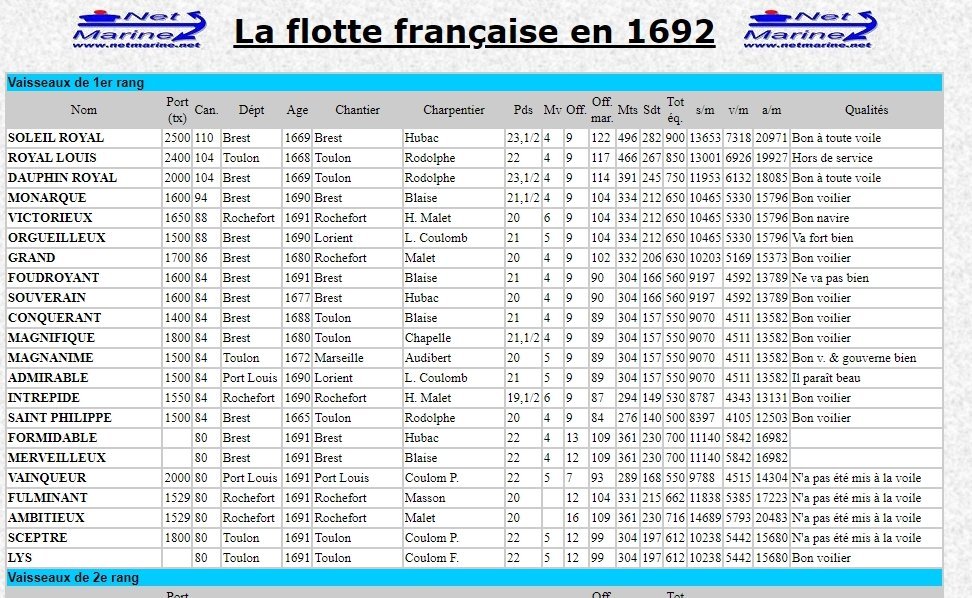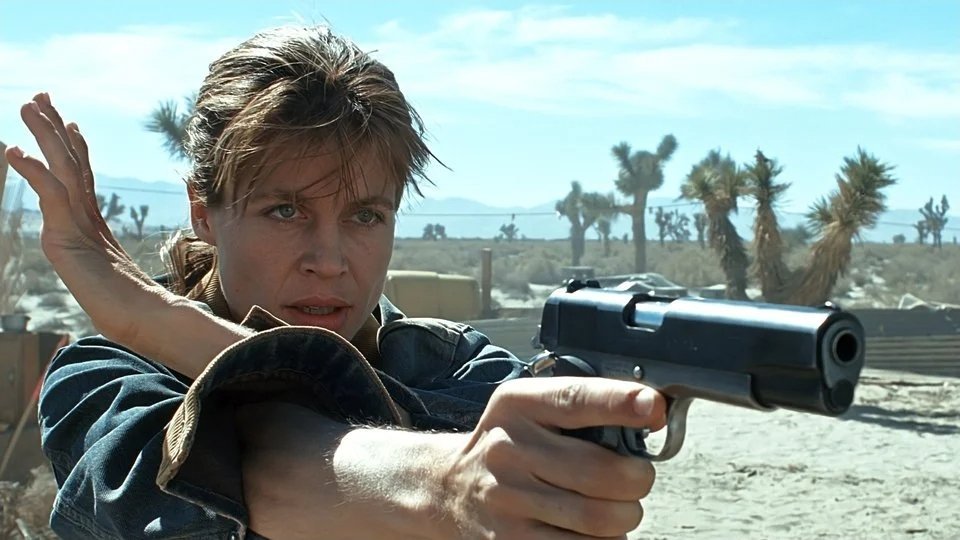-
Posts
297 -
Joined
-
Last visited
Content Type
Profiles
Forums
Gallery
Events
Everything posted by HAIIAPHNK
-
Thank you for your input and suggested option. I was considering placing a cannon porthole in that location. This was before we even got the original sketches. And I only had the book drawings for the Ambitionary on hand at the time. At that time the whole quartet gallery drawing was a complete fantasy. But that option had to be abandoned. On the given sketch at scanning became worse quality, but it is still possible to discern. The azure lines show the belt where all the cannon portholes go. If the cannon is placed in the place you suggested, it will be above the planned level. No one would make a separate carriage with a higher position of the cannon barrel. And then it was necessary to change the gallery drawing, to lower the window level. In principle it is possible, but in the end it would be too far from the source. But the next problem will not be avoided for sure. If you look closely, you can see the doorway in the same drawing. It crosses the border of the window to the left of the viewer. Do you see it? So the porthole and the doorway will be one huge hole in the hull. Which is impossible. We conclude: if we have given up the idea of putting the cannon in the doorway itself, then we are left with only two options - the cannon can stand either in the last section of the porthole or already on the gallery's edge. The cannon outside the gallery was also discussed, and it was also rejected.
-
Stones for grinding decks were certainly used. Water + sand and this mass was rubbed on the deck with stones. Then it was washed off with clean water. Cleaning was necessary not so much because of splinters, but rather to remove salt from the deck. Which harmed bare feet much more often, because it was all over the deck. Remember in the movie about Captain Aubrey the moment with the cleaning of the deck? As to the question, what could there have been but brooms and mops? What else do you need for cleaning? You can think of scoops or trowels, of course. A ship is no different in this process than any home. If these simple tools are enough, what else do you need to clean a ship? The process itself is also quite predictable. Today, many people who are forced to clean simply pretend to clean. And instead of a proper process, they sweep the trash where it is less visible. I think people are still the same in this and many used to do much the same thing. And some of the trash gradually migrated lower and lower on the decks. And eventually ended up in the hold. As they say, ballast is also needed on the ship, I brought some more 😄. The tools were stored in the bosun's room. Next to rags, ropes and tar. We can mention one more item related to cleaning. I don't know how appropriate it is to equate this with the usual brooms and mops this item is, but it is also part of the cleaning process. This is a limber rope. It's a long rope that was knotted at intervals. This rope was inside the limber hall, at the very bottom of the ship. Sooner or later all kinds of debris would fall to the bottom and get clogged up in this drainage channel. That's what the cable was for. It was used to clear the debris. When it was clear from the condition of the rope that it was beginning to rot, a new one was tied to one of the ends and pulled into the limber hall in an understandable way. This conduit is not often mentioned. But it's interesting. There were different designs at different times. The Dutch were very different from the English or French. It seems like an insignificant detail, but without it, the ship could rot much faster. I've gone beyond the boundaries of your interest. But maybe this also fits into the topic of cleaning....
-
The second thought is separate from the first and has to do with the cannon porthole, which is what you gave me good examples and advice on. I will try to explain what exactly concerns me about this issue. As you have noticed, I have dived deeper into the description of this topic than just appearance. Yes, of course, I can just do the ultimate "picture" of this issue. And either show the cannon itself, or cover everything with a window (real or false) altogether and remove the presence of the cannon from view. But! This would all be enough if I was building a regular, classic model. In my case we are talking about the Admiralty version. I use the term I am used to. I hope that in English the type of model, when deliberately not made the outer skin and shown internal engineering device is called by the same term. And since I will be able to see both the cut porthole and the structural skeleton of the gallery from one side, I need to understand as accurately as possible what exactly the details look like, which in a classical model I would not need to show. That is my task: to understand the correct construction. Different situations may well arise as the construction progresses, but if I need to leave something open I care about correctness on all layers. And I am very grateful for your help.
-
Thanks for the feedback and great examples. I will try to respond to your comments and explain what exactly I am trying to clarify. There are two separate topics in my post with the photo of my interpretation that were important for me to show and listen to advice. 1 thought: This is a general view. After a number of discussions, I took educated advice and tried to combine your opinions, namely to leave the overall width of the side gallery design uncompressed and to compose the cannon porthole so that it falls within the gallery area. Along with this I have tried to take into account the advice that the slope of the horizontal directions should be combined with the walles. And I would like to get an outside opinion. Whether the overall pattern is correctly designed. Whether the slopes of the balconies do not look erroneous. I have already written that I can not explain for what reason Beren broke the vertical directions? Why in his sketch they don't go straight? So I took the risk of doing it differently. Suddenly someone knows the reason and will see that I "tweaked" Beren for nothing? This is the first main thought with which I posted my drawing.
-
The issue of the porthole in the quarter gallery remains unresolved. The construction of the gallery at Budrio on the ground floor is shown as a single room, inside of which one can stay. Now, when instead of one window (real or false) there will be a porthole for the cannon, it is necessary to think how it will look like. Will the lower tier remain a single room, as on Ambiteaux, or is it more correct to cut the room on the border of the window (which is in the middle) and the part of the gallery under the cannon will be blind, as for example on Fleuron? Also I have not yet come to an answer whether to leave the porthole as an open hole or to hide it behind the gallery window? How should this window be opened then? In my opinion, these questions are mutually influencing each other. If you leave the room whole, then inside this gallery you can go to the window and remove it completely or open it like a normal window. If the room is shortened, then it will be more difficult to reach the window and in this case it would be more logical to remove everything that could interfere. And leave the cannon porthole open.
-
The next step is in the works. Redrew the quarter gallery design, taking into account the ship's hull. Here's what I got. Unfortunately, when transferring the drawing on paper to digital format, the quality is lost. After thinking about it, I decided to align the broken directions into a correct line. Maybe it's a mistake on my part, as I don't know the real reasons why it was done this way in Beren's drawing. But since I never figured out the reason, I did it the way I understand it. What does it look like from the outside with non-tired eyes? What do you think? Any comments? Maybe I missed something important and made mistakes?
-
Actually there is another reason why I try to make the lion from the ship with Vasa closer to a museum piece. Why I started doing this whole lion collection. And how this scale was chosen. It's a whole story. At first I wanted to write about it, but I decided that again I would go far away and did not publish anything from this story. But there was a reason for the artificial chipping and implants.
-
Thank you so much for the high praise. I myself find it interesting to look at the sculptures and think about how they were made back in the day. Why not repeat the same way or at least do an imitation of it. Also, the scale I chose is so large that I would be remiss not to show such detail on this lion. More often it happens that you make a model in 1:100 scale and think that you will have to agree to conventions, the figure is too small to show everything on it. But here there can be no excuses.
-
The next step in the work. The work has long since crossed the equator. The rough work is turning into refinements and finer treatments. And now it is time for the sculpture to be customized. The original figure in the museum shows well how exactly the overall volume was assembled from the individual components. You can see the seams and traces of fasteners. It is time to show them. And at the same time to pay attention to another feature of the figure, which tells about how the construction was carried out. We are well aware that wood is a living material. It cracks, breaks. And we have to take that into account. And if we are talking about a warship, we can add to this the breakdowns that occur during the voyage. These can be accidents or damage that occurs during combat. And such damages are solved with the help of repairs. If it is possible to do without a complete replacement, plugs and implants are inserted in the damaged place. And this applies to the decor as well. The movie about Captain Aubrey and how the crew repaired the broken figure immediately comes to mind. There are also places on Gustav's figure where inserts and implants are visible. Only here it is of particular interest. After all, the ship wasn't involved in any battles. It hasn't even sailed. And the condition that we can look at today can be called perfect. Brand new. Fresh off the assembly line. And then all of a sudden we see these marks on the lion. Can you imagine a situation where you buy a new car. You pick it up from the dealer. It's brand-new. Smells like fresh plastics and leather. Parts and seats have protective film and covers on them. The whole car is shiny with new paint. But then you open the trunk and see traces of putty that was thrown over the dented area. We can't imagine such a thing. And if today discovers a defect on a new purchase, we immediately return the low-quality thing back. And here, on the ship, no one began to change the spoiled and remake again. They just put in the inserts, nailed them in and painted over the top. Interesting detail, isn't it? You can take these little touches in many different ways. You can be surprised and say: Wait a minute, the front paw is quite small, it could easily have been replaced in its entirety to make the figure perfect. Or you may say: Why do unnecessary work? Look, it's just a small part. It doesn't bear any load. Nothing will be weakened by her having an implant on the ship. We've got a lot of work ahead of us. We're not going to redo anything. In reality, it could have gone either way. And the chief sculptor could have made both of those decisions. Or he might not have known about the breakage at all. For example, some ordinary carver was attaching this paw and a nail caused the part to burst. And he quietly and inconspicuously inserted a plug and painted over the damaged place so that no one would know about the problem. That could have happened, too. Today we cannot say exactly how it happened. However, today we can see that our ancestors were not maximalists. They could calmly accept the fact that their work had faults and defects. And now I try diligently to replicate these implants and make artificial chipping so that my figurine becomes similar to the historical original.
-
It's as simple as that. Then everything falls into place. I see that I'm not making any logical sense with the theories I'm coming up with. So now I leave the door alone, it is already in the hull and should be justified and the exit to the captain's toilet should remain. I make a cannon porthole next to it so it is in the gallery area. And the gallery itself doesn't need to be compressed now. It turns out roughly like this: Now I need to transfer the gallery drawing from Beren's sketch and combine everything together. The topmost oval porthole at the end of the QD remains a point of contention. And Demerliac's data about a pair of cannons on the poop. I'll leave this question aside for now, I'll finish drawing the gallery first, it should take up more space, there and the dome is more rounded. Let's see how much free space will be left in the end.
-
I'm already drawing new variations based on the new information. In fact, we've almost come to the same solution on our own. The idea of putting the cannon in the doorway was logical. Except that I missed with the second one, I put it outside the gallery. But somehow I think that after the next sketch we would return to the idea of leaving the gallery the same length as on the original. One can speculate a lot, would we have come to this option or not? But this drawing certainly sped up the thinking and searching. Maybe someone has other drawings of this ship? It has become very interesting to look at it in more detail. For example, I have the impression that the outermost cannon on the MD stands higher than the others. This is tied in with the window here, most likely. So as not to break the drawing the cannon looks out of the window. But then it appears to be standing on some sort of bench or catwalk? It seems like a lot of complications for the sake of keeping the appearance intact. Is it just me or are there similar cases? Was there a very small caliber gun standing there that such a gun could be used on a table, raised, lowered? Or was the catwalk permanent? And could the balcony itself be used? Was there an exit left there, or was only a porthole left and the balcony not used as a room? In principle, the captain could climb out through the porthole, but it is still not very consistent with the position of the captain. And if the captain is also of advanced age? I think I just found the answer. And it has its own interesting nuances. The detective continues!
-
I can only agree. Yes, I know there are places on the ship where the gun is not permanently mounted. When necessary, some cannon portholes were dragged to some cannon portholes by neighbors, or those that were not in use during a given period of combat, such as from the opposite side where there is no one to shoot at. And this was the norm. First of all, such practice was for chase guns. It is simply impossible to put permanent cannons here. They would interfere with the guns on the sides. Plus you also have to take into account that during the battle the cannons need room to roll back. So each cannon on the end of the ship will interfere with 2 or 3 cannons on the sides at once. In Russian, a cannon porthole without a permanent cannon is called a retirade port. And how is it correct in English? Thank you for helping with advice. I am more interested in this question how to correctly perceive the list of cannons in reference books. Demerliac says that there should be 98 cannons. Is it meant by the number of portholes? So there are actually fewer cannons. Or is it exactly 98 cannons plus empty ports? I always thought that such data is about the first variant, am I wrong?
-
You're absolutely right. Decor drawings are a separate topic. There is a lot to talk about and different aspects to remember. I don't know what sources Budrio was working with in this case. Therefore, I can't speak unequivocally about poor drawing skills. French lions could have been very different. On the one hand, a French lion could be very correct, almost photographically accurate. And at the same time, it could be not very correct. I don't know what the lion was like on this particular model. In this story I had to find out more precisely the wishes of the customer before I started the work. And I missed this point. So it was my mistake. So when everything turned out I removed the first attempt of carving and made a new lion. And in general I like the design of Ankre's books. And the artist's hand drawing the illustrations is very impressive. The four-volume book on the 74-gun ship is the pinnacle for me. So detailed, simple and clear are the illustrations and how they are all supported by explanations. Drawing decorations is not an easy thing to do.
-
I really hope that my verbosity will not break heads and the translator will faithfully translate everything I want to express. I am very thankful for all of you being helpful and sharing your opinions. Maybe there will be some good advice with everything written. Maybe I am lost somewhere in my thinking.
-
We see that there are no cannons drawn on the sketches, which could affect the appearance of the galleries. The customer wrote that he wants to leave these galleries in this form, to try to leave them in their original form. And all the additional guns should be inserted outside the galleries. And everything would be fine. My job is much easier. I don't have to think of anything, just take it and build it. That's great! So I started to do the adaptations. Which I tried to describe in detail. After all, even the question of leaving the gallery in the same form as on the sketch has already encountered questions. Will really look beautiful exact repetition of the drawing? Maybe it still makes sense to make changes and deform the original drawing to fit the existing hull. And plus it is still necessary to think about the fact that sooner or later cannons will have to be placed somewhere. And if you don't think about it now, it will be a problem later. And first of all it concerns the question whether to leave the quarter galleries so long or will have to shrink them? If we take into account that the customer has set a condition that there should be no cannons on the territory of the galleries, the width of these structures is a very important issue. Which I have tried to show with the help of the last diagrams. And now our detective takes it to the next level! The customer sent a letter, in which he chose a specific description of Fulminant, where it is clearly described and the number of guns and where, on which decks they should stand. I don't know how to read it all from the outside. But for me, the plot became more than just detective story, it became sci-fi or even mysticism. I just don't know now how to put it all together at the same time. I'm transcribing what Demerliac writes about weaponry into the text in a column: LD - 28 (28) MD - 30 (26!) UD - 26 (24) QD - 12 (4!) poop - 2 (0) The numbers in parentheses are what is currently available on the case. To make it easier to compare. To be honest I don't know exactly where to put the chase guns of both hull ends. The aft ones are LD and the forward facing ones are UD. But that's questionable. I also did not understand how to understand the number 12 in Demerliac's list on QD. There is not much space there. Where is it possible to fit that much in there? Maybe chase retirade positions in front should be included in the same line? But that's also a very strange thought. How can what is on the very bow of the ship be classified as QD? This is my misunderstanding after all, don't think Demerliac missed something. By the way, he has marked (most likely retirade) positions on the poop. Which means that if you put Domerliak's data as capitalized, you will have to modify the decor on the transom somehow. And it will be necessary to make there either open portholes, as on Forecastle, or to put hidden hatches. But it is not so difficult. What is more difficult is that in the existing realities it is impossible to make everything match exactly everywhere. It is possible, of course, to start construction from scratch. But that's fantasy, isn't it? And any other attempt to solve this conflict without changing everything is definitely mystical. You'd need a magic wand or parallel space or something. Something has to be sacrificed. And that's either turning a blind eye to the exact number of guns on each floor, or accepting the fact that you'll have to adjust the appearance of the galleries quite a bit. Let's leave aside all other issues. Let's take a look at just one line. MD - 30 (26!) This means that not one, but two guns should be placed on the 2nd deck. That is, you need to compress the gallery a lot and at the same time place the second gun in the gallery window. And this gun will most likely have to be in the doorway. Which is not a bad solution. Then theoretically in the marching state the cannon can stand sideways inside the captain's cabin, and the captain can use his toilet. And during the battle the cannon is put in the combat position, the window is tilted and you can fire. These are purely theoretical speculations of how everything can be combined together in a single issue. As far as it all really met in practice I will not say for sure. And I put out of brackets the discussion of how much the interior space of cabins changes. It is difficult to think about it at all. It's such a tangle of questions. And one part of the puzzle inevitably affects the neighboring parts. It's impossible to keep everything at the same time.
-
So, I will try to describe in order everything that may be relevant to the topic of the appearance of quarter galleries and how the number of guns may affect it. The topic is very big and complicated. I drew a lot, racked my brains with versions. Often from the outside I looked like this: And sometimes, at particularly difficult moments, even like this: For what reason, you'll soon find out. What do we have? A ship hull that is already built from Ancre's blueprints and was, up to a certain point, Ambitious. Then the decision was made to redesign its appearance so that it would be the first model of the Fulminant. After all, the ships are twins in design. And theoretically all can be easily adapted to new tasks. However, the ships have differences. One of them is the different amount of artillery. At the same time in different sources you can find different amounts of this very artillery. In any case, the Fulminant must have more guns and somewhere to find porthole spaces. So I set about that search. I looked for different ways to find some space somewhere. And this was even before there were grisailles with the appearance of Fulminant's quarter galleries. That's why I started from the book version. The subtleties of design are not so important to me at this stage. It was necessary just to understand approximately what volume should occupy the total dimensions of these galleries. And that's what the options were. This is just the arrangement of all the places, if you do not look at the shape of the galleries and start from the distance to the cannons: Here are the options now taking into account the drawing (approximate) quarter galleries. I will mention at once that there should be no additional cannons on the transom area, it was a condition from the customer. I do not want to break the decor, especially since on the only sketch to that moment there is no mention that there are chase guns. So we have to look for places on the sides of the ship. Here are what the options were: I'll make a separate note of the cannon in the farthest corner. I found only one mention that this location could actually accommodate a carriage. Let it be a British ship, I did not find such a mention on the French ones. But one has to find places somewhere. And now it's time to get to the numbers. How many guns should we add? As I have already said, in different sources the information on this matter differs Now on the hull there are 90 barrels (or more correctly places). I describe in more detail where exactly and in what quantity they are all located: LD - 28 MD -26 UD - 24 QD - 4 plus 4 cannons on Lower counter and another 4 chase guns (most likely retirade) on Forecastle. Total: 90 gun emplacements. And different sources say there should be between 94 and 98 guns on Fulminant. At this point we received word that the archive would grant the request and we would soon be able to get Beren's grisaille. At this stage, the customer suggested to postpone assumptions for a while and wait for the sketches. And then it would be clearer. They are here. And what do we see? To be continued...
About us
Modelshipworld - Advancing Ship Modeling through Research
SSL Secured
Your security is important for us so this Website is SSL-Secured
NRG Mailing Address
Nautical Research Guild
237 South Lincoln Street
Westmont IL, 60559-1917
Model Ship World ® and the MSW logo are Registered Trademarks, and belong to the Nautical Research Guild (United States Patent and Trademark Office: No. 6,929,264 & No. 6,929,274, registered Dec. 20, 2022)
Helpful Links
About the NRG
If you enjoy building ship models that are historically accurate as well as beautiful, then The Nautical Research Guild (NRG) is just right for you.
The Guild is a non-profit educational organization whose mission is to “Advance Ship Modeling Through Research”. We provide support to our members in their efforts to raise the quality of their model ships.
The Nautical Research Guild has published our world-renowned quarterly magazine, The Nautical Research Journal, since 1955. The pages of the Journal are full of articles by accomplished ship modelers who show you how they create those exquisite details on their models, and by maritime historians who show you the correct details to build. The Journal is available in both print and digital editions. Go to the NRG web site (www.thenrg.org) to download a complimentary digital copy of the Journal. The NRG also publishes plan sets, books and compilations of back issues of the Journal and the former Ships in Scale and Model Ship Builder magazines.





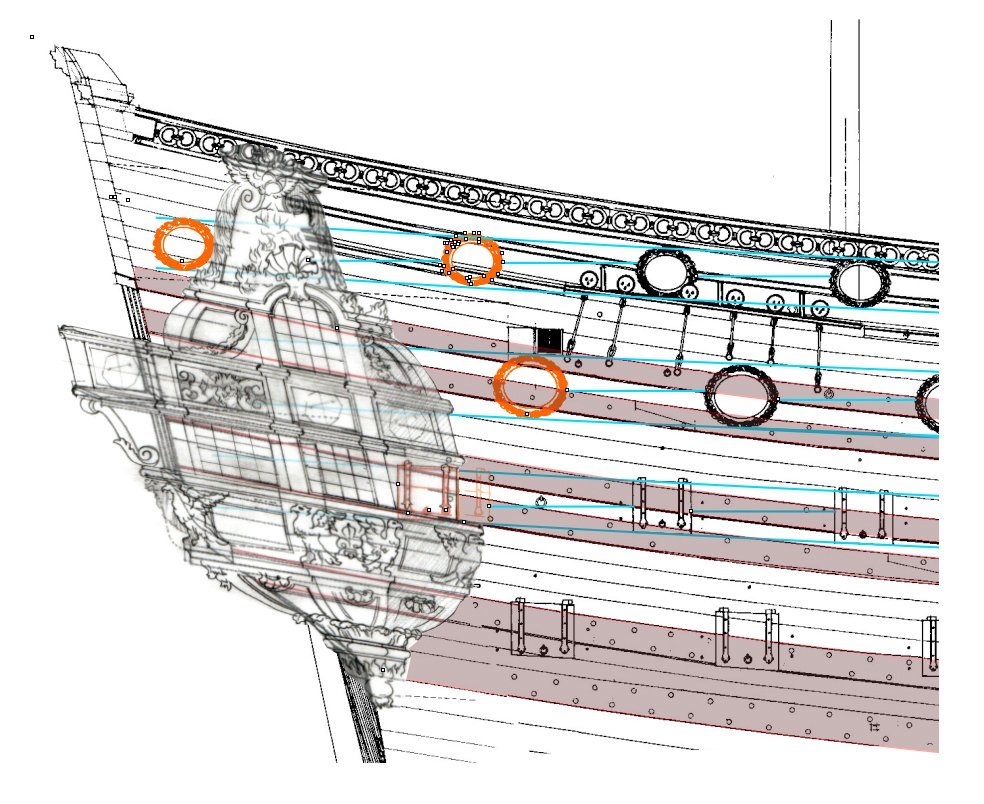
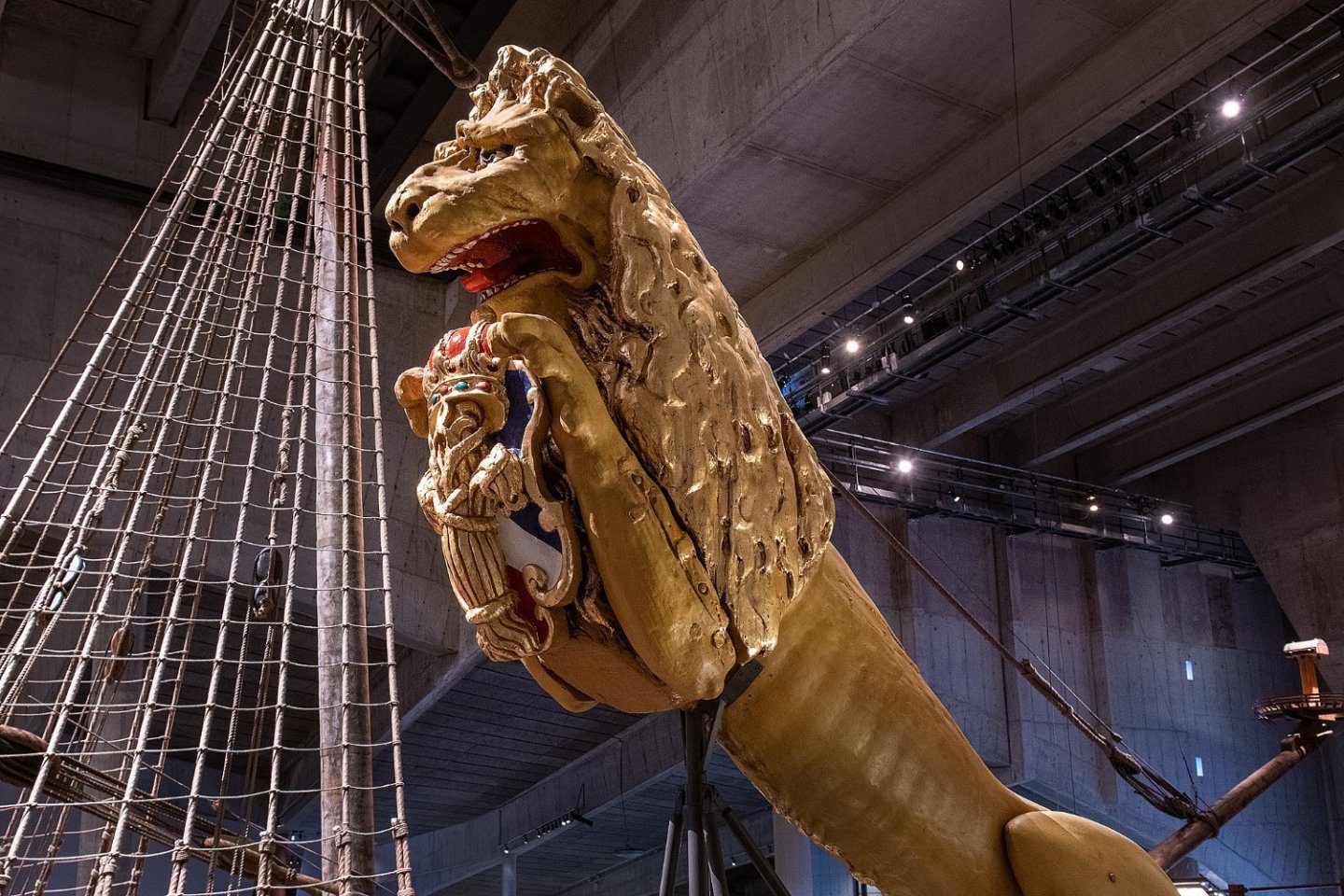
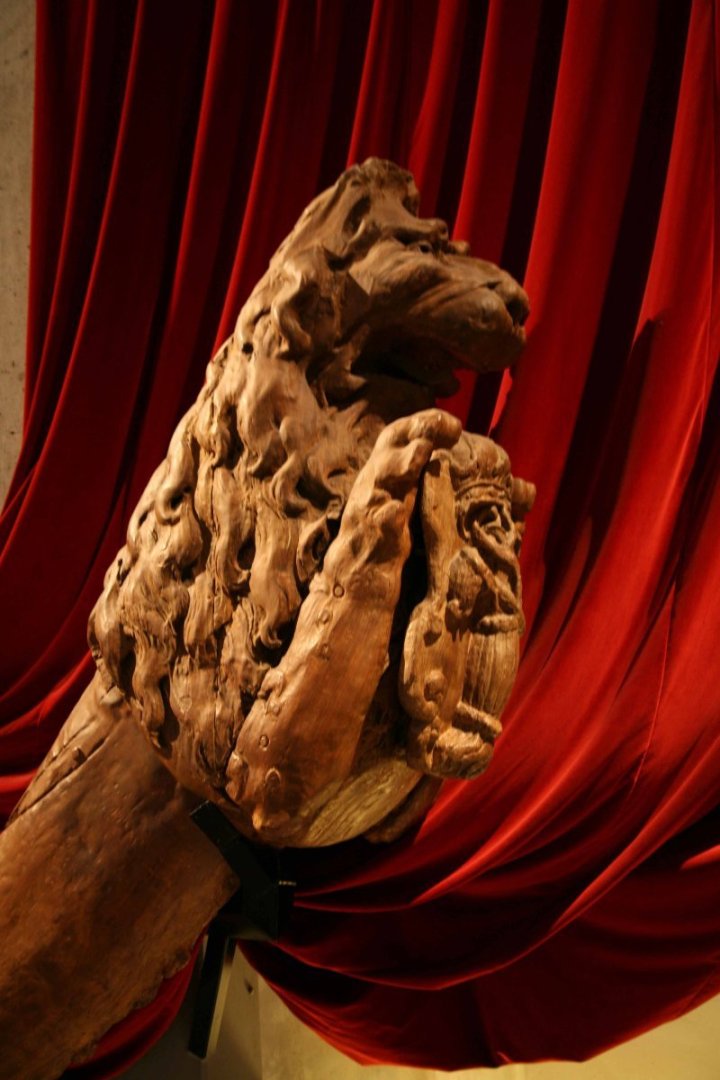
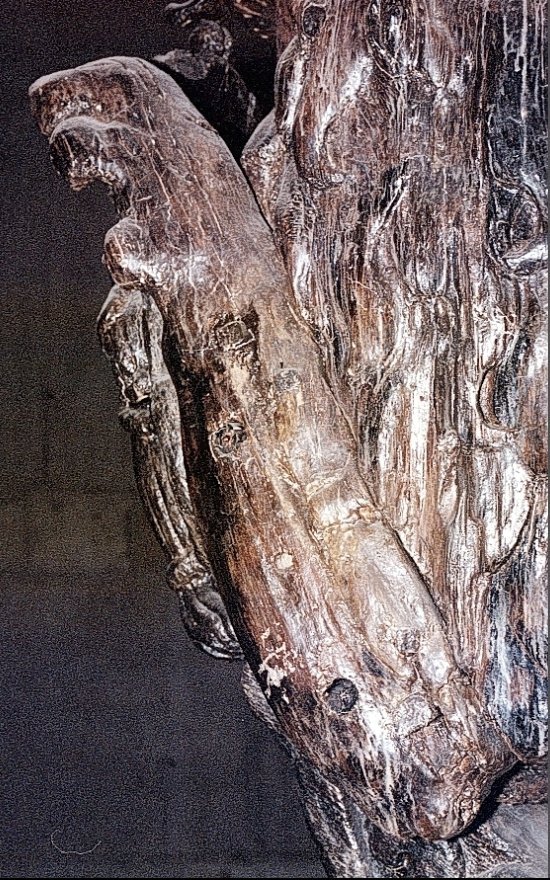
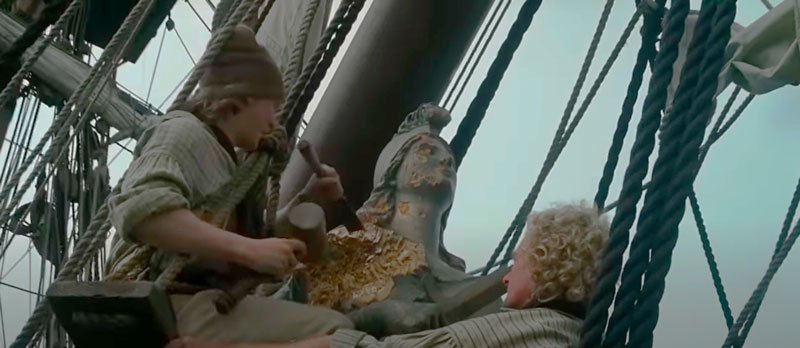

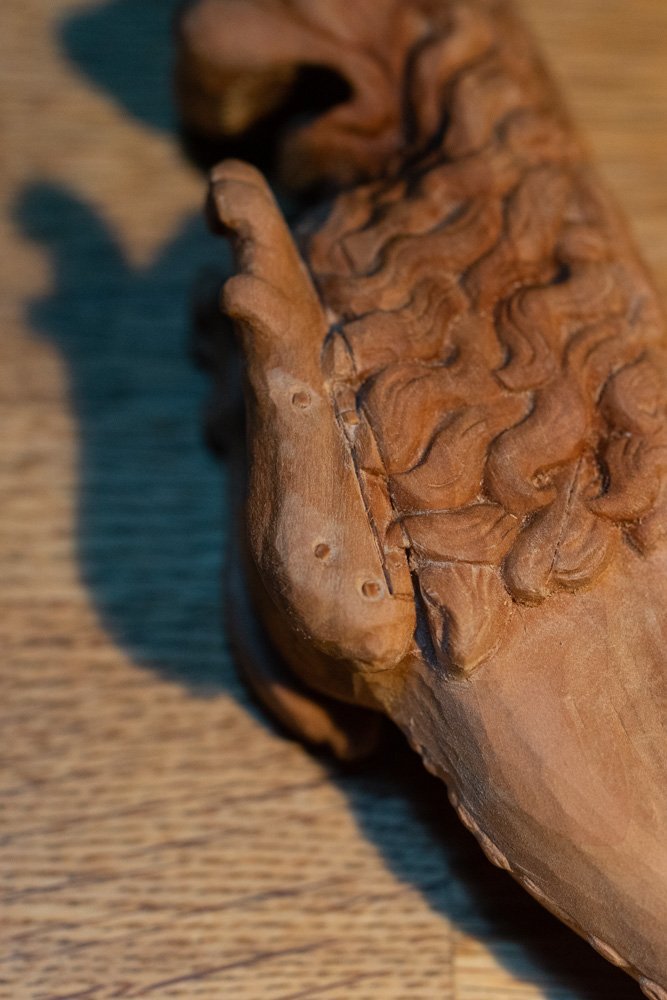

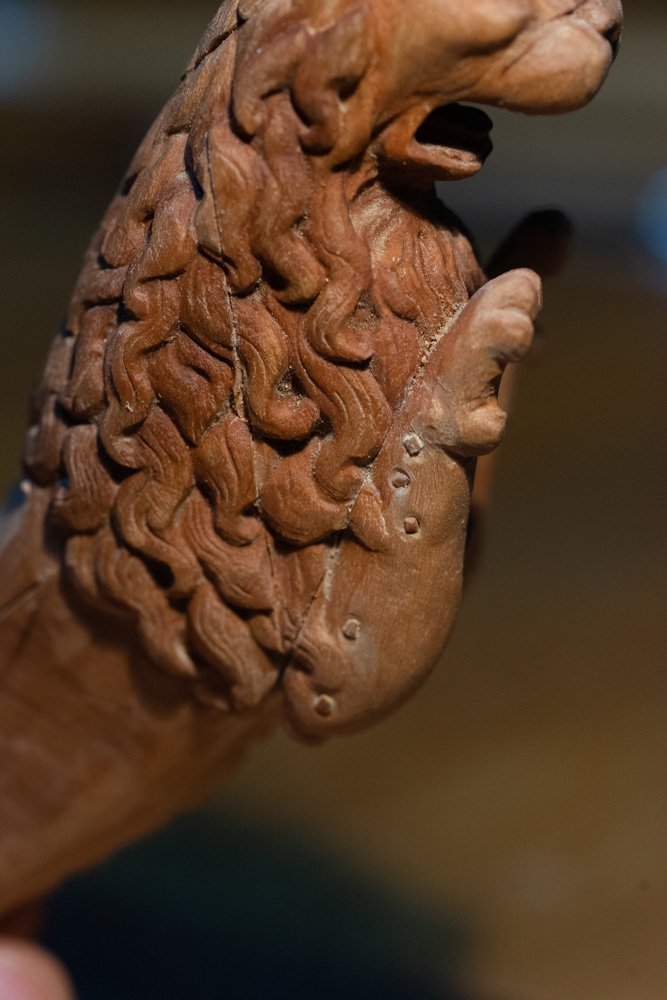

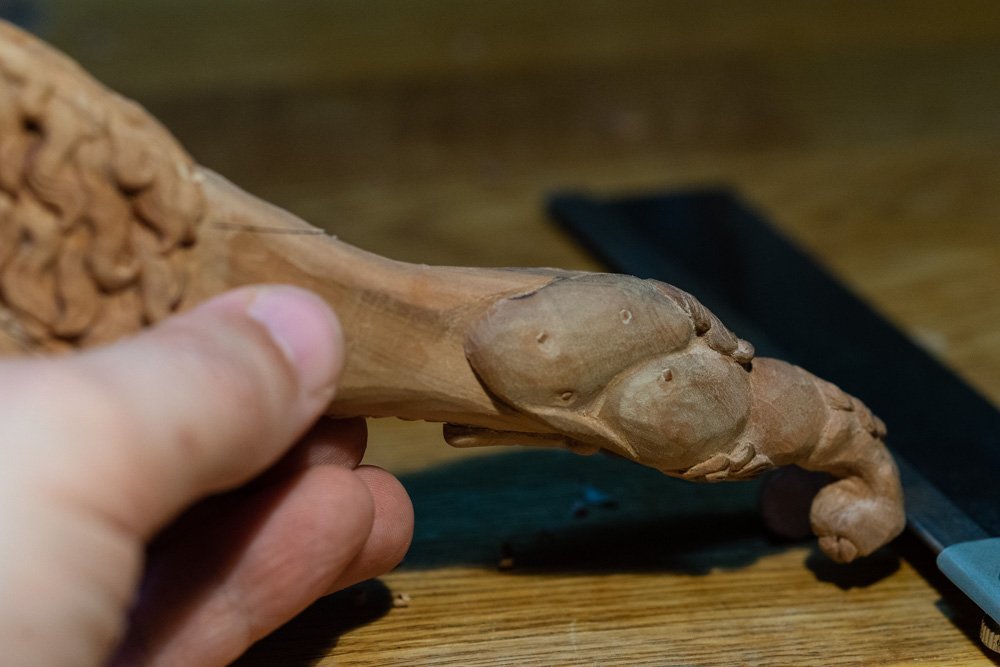

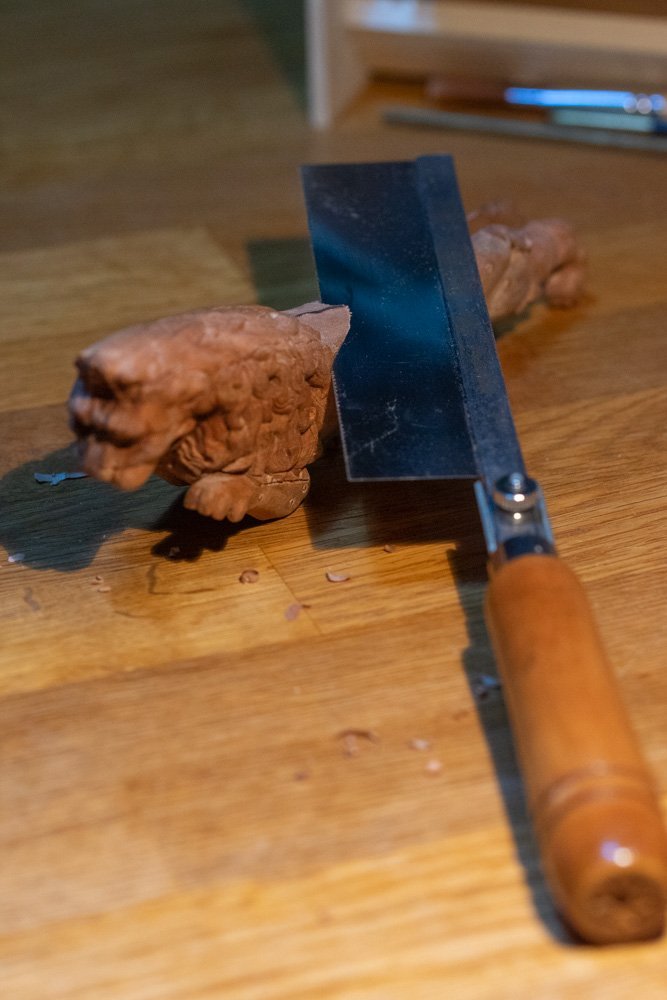
.thumb.jpg.7257058d8ee5a60b0e918204b1f43919.jpg)
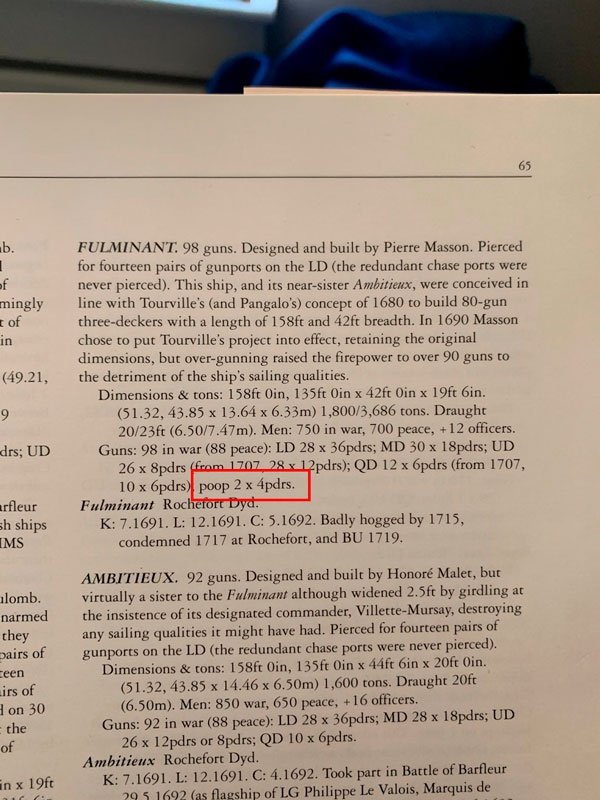
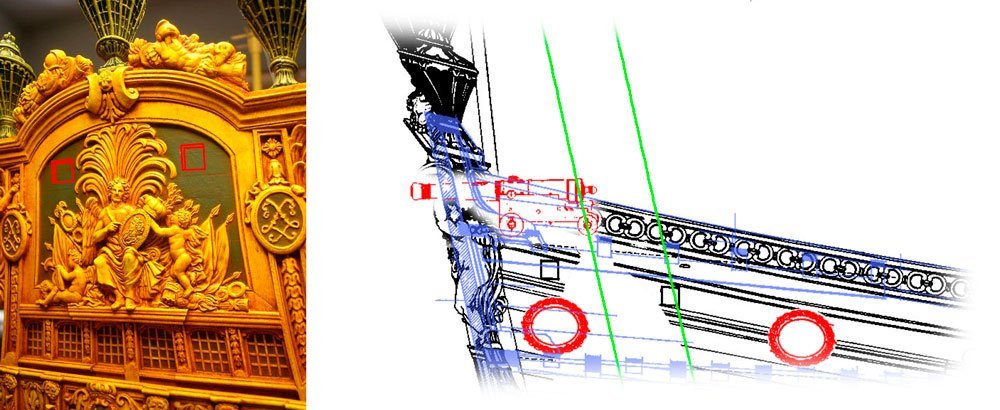

.jpg.2e806cd47f0788a0e98144b36ef407f7.jpg)
